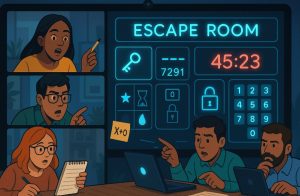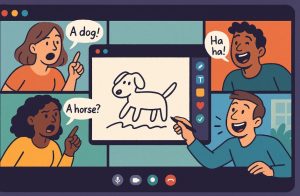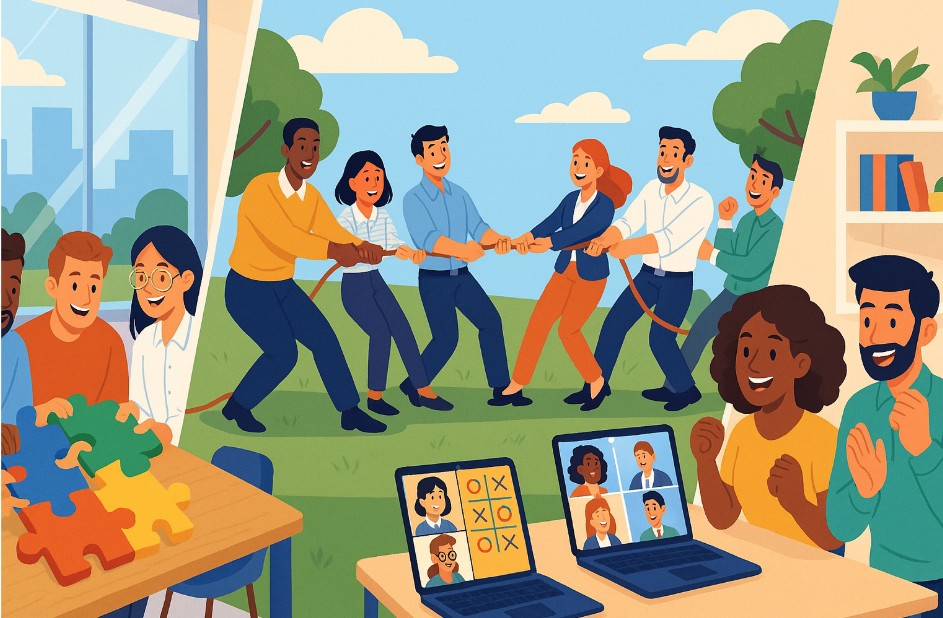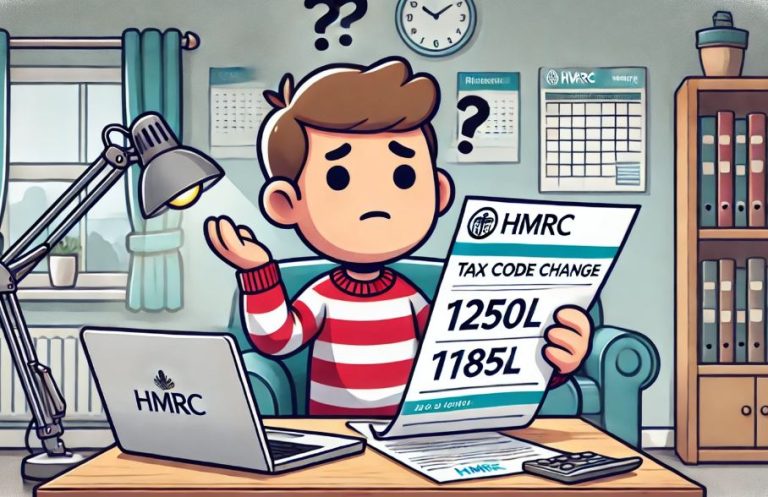Why Team Building Games Is Important for Business? | Top 25 Games
Did you know that companies with engaged employees outperform those without by up to 202%? In today’s competitive business world, team building games are more than just a fun diversion they’re a strategic tool that can significantly enhance team cohesion, productivity, and morale.
Team building games are structured activities designed to bring individuals together, encouraging collaboration, communication, and a sense of belonging. Whether it’s through problem-solving tasks or creative challenges, these activities are vital for developing trust and unity in any business environment.
In the UK, the adoption of team building activities has surged as companies seek ways to increase engagement and drive performance. They are now considered an essential part of corporate development strategies.
Why Team Building Games Is Important for Business?
Investing in team building games offers a multitude of organisational benefits. Here are the core reasons businesses in the UK are making them a regular part of their employee engagement strategy:
Improve Employee Morale and Motivation
Engaged employees are happier and more productive. Participating in games and challenges that are not strictly work-related helps alleviate stress and provides a positive outlet.
Boost Team Productivity and Engagement
Games encourage teamwork, and teams that play well together tend to work well together. It sharpens focus and instils a sense of shared purpose.
Enhance Communication and Trust
Trust-building exercises and games that rely on communication (like Escape Rooms or Problem-Solving Challenges) can significantly improve how employees interact in the workplace.
Encourage Collaboration and Team Bonding
Collaboration goes beyond sharing tasks. Team building encourages open dialogue, empathy, and deeper workplace relationships.
Leadership Skill Development
Certain games highlight natural leadership traits and give employees a chance to step up and lead, helping identify and cultivate leadership potential internally.
How Team Building Games Support Employee Engagement Strategies?
Team building games can directly support broader HR and company culture initiatives. Here’s how:
- Reinforces company values through activities that model collaboration and trust.
- Promotes inclusivity by engaging diverse team members in low-stakes, fun environments.
- Improves retention as engaged employees are more likely to stay long-term.
- Supports learning and development through hands-on, interactive experiences.
According to a report by Gallup, organisations with high employee engagement see 41% lower absenteeism and 21% higher profitability. Team building games are a proven way to support this engagement.
Top 25 Team Building Games for the Workplace
Whether you’re running a small startup or a large corporate office, here are the top 25 tried-and-tested games for boosting team dynamics.
Indoor Team Building Games
1. Office Trivia

Time Required: 20–30 minutes
Ideal Team Size: 4–10 participants per team
Purpose: Enhancing team knowledge, bonding through shared experience, and light-hearted competition.
Office Trivia is a classic, low-prep indoor activity that’s perfect for energising a workplace while subtly reinforcing internal knowledge.
You can divide participants into small teams and quiz them on general knowledge or, better yet, company-specific facts such as fun moments in past meetings, office inside jokes, or departmental achievements.
This not only encourages interaction but also instils a deeper appreciation for the organisation’s culture.
It’s a perfect midday pick-me-up or end-of-week engagement exercise, especially for teams looking to improve camaraderie in a stress-free way.
2. Escape Room Challenge

Time Required: 45–90 minutes
Ideal Team Size: 6–12 participants per game
Purpose: Promoting problem-solving, critical thinking, and group decision-making under time pressure.
Whether you set this up physically in the office or use a digital escape room platform, this immersive game puts teams in a scenario where they must work together to solve clues and “escape” within a limited time.
Each puzzle demands collaborative thinking and effective communication. Escape Room Challenges are especially effective for mid-to-large teams looking to improve synergy and team coordination.
They also offer a fantastic opportunity for identifying natural leaders within the group based on how team members navigate tasks and delegate responsibilities.
3. The Marshmallow Tower

Time Required: 20–30 minutes
Ideal Team Size: 3–6 participants per team
Purpose: Encouraging creative problem-solving, teamwork, and time management.
This popular engineering-based challenge gives teams a simple goal: build the tallest free-standing structure using just spaghetti sticks, string, tape, and one marshmallow (which must sit on top).
It’s deceptively tricky and incredibly effective for testing how well a group plans, adapts, and executes under time constraints.
The Marshmallow Tower activity often surprises teams those who spend more time planning and less time building tend to perform better.
It’s a great game for helping teams understand the importance of strategy and communication, rather than rushing through tasks.
4. Who Am I?

Time Required: 15–20 minutes
Ideal Team Size: Unlimited, played individually or in groups
Purpose: Enhancing communication and listening skills in a fun, relaxed way.
This guessing game involves sticking a name of a famous personality, fictional character, or even a colleague on each participant’s back or forehead. The player must then ask others yes/no questions to figure out who they are.
The magic of this game lies in its simplicity and the laughter it generates. It’s perfect for breaking the ice in a new team or energising the room before a brainstorming session.
Beyond the laughs, it encourages participants to listen carefully and ask thoughtful questions skills essential in the workplace.
5. Two Truths and a Lie

Time Required: 10–15 minutes
Ideal Team Size: 4–20 participants
Purpose: Building trust, promoting openness, and encouraging conversation.
Each team member takes turns stating three facts about themselves two that are true and one that is false. The rest of the group must guess the lie.
While it sounds simple, this game is incredibly powerful for humanising colleagues and breaking down hierarchical barriers. It helps people connect over shared interests or surprising revelations, and fosters a sense of inclusion and belonging.
It’s best used with newer teams or when onboarding new staff, as it creates a more open and engaging environment.
6. Puzzle Solvers

Time Required: 30–45 minutes
Ideal Team Size: 4–6 participants per group
Purpose: Strengthening collaboration, patience, and shared achievement.
In this mentally stimulating game, teams are given a complex puzzle be it a jigsaw, logic problem, or a brain teaser and must complete it within the allocated time. The task encourages participants to collaborate, divide responsibilities, and help each other under pressure.
Puzzle Solvers is an excellent metaphor for real-world work situations where a team must assemble the pieces to reach a common goal. It’s especially useful in assessing how well team members align their problem-solving styles, making it ideal for performance development and team workshops.
Outdoor Team Building Games
7. Scavenger Hunt

Time Required: 60–90 minutes
Ideal Team Size: 4–8 participants per team
Purpose: Enhancing teamwork, strategic thinking, and problem-solving in a dynamic environment.
A Scavenger Hunt is one of the most popular and effective outdoor team building activities. Teams are given a list of items to find or challenges to complete within a designated area and timeframe.
It could involve snapping photos, collecting items, or solving clues. What makes this activity particularly valuable is its ability to bring out each member’s unique strengths whether it’s analytical thinking, navigation skills, or creative problem-solving.
It fosters a spirit of collaboration and healthy competition while allowing participants to step outside the usual office environment, boosting energy and morale.
8. Tug of War

Time Required: 15–30 minutes
Ideal Team Size: 6–10 participants per team
Purpose: Promoting unity, physical engagement, and competitive spirit.
Tug of War is a timeless physical game that requires collective strength and coordination. Teams line up on either side of a heavy rope and pull with all their might to bring the marker across a designated line.
Though it’s simple in nature, the game promotes quick decision-making, group strategy, and full-team effort.
It is particularly effective for reinforcing trust and reliance between team members, especially in larger groups where coordination is key.
It also provides a fun and energising break from mental tasks and is great for all-staff events or outdoor retreats.
9. Relay Race

Time Required: 30–45 minutes
Ideal Team Size: 4–6 participants per team
Purpose: Strengthening coordination, team pacing, and individual accountability.
A relay race involves teams completing a series of physical or mental challenges, passing a baton (or symbolic item) from one member to the next.
The beauty of this activity lies in its adaptability you can customise each leg of the race with challenges like balancing exercises, riddles, or even office-themed tasks.
It encourages strategic planning, as teams must assign roles based on each member’s strengths.
The emphasis on seamless transitions between team members mirrors workflows in business settings, making this a fun yet meaningful exercise in coordination and execution.
10. Human Knot

Time Required: 15–25 minutes
Ideal Team Size: 6–12 participants
Purpose: Building trust, patience, and physical collaboration.
In this close-contact activity, team members stand in a circle, reach across to grab hands with two different people, and then work together to untangle themselves without letting go.
The Human Knot is both amusing and physically engaging, sparking laughter and creative problem-solving as the team figures out how to move collectively.
It’s particularly effective at encouraging communication and trust, as members must listen, cooperate, and consider each other’s comfort. It’s a light-hearted but powerful metaphor for navigating workplace challenges as a cohesive unit.
11. Capture the Flag

Time Required: 45–60 minutes
Ideal Team Size: 8–16 participants
Purpose: Fostering team strategy, planning, and collaborative competition.
Capture the Flag transforms any open outdoor space into a strategic battlefield where teams attempt to capture the opposing team’s flag while defending their own.
It encourages planning, delegation, and real-time communication, all under pressure.
Each player has a role some defend, others attack so it’s an ideal game for practising situational awareness and aligning individual tasks with a broader team objective.
This is a particularly useful game for leadership development, as it naturally spotlights decision-makers and team influencers.
12. Egg Drop Challenge

Time Required: 30–45 minutes
Ideal Team Size: 3–5 participants per group
Purpose: Stimulating innovation, resource management, and collaborative thinking.
In this imaginative engineering challenge, teams are given basic materials like straws, tape, newspapers, and cups. Their task is to build a contraption that will protect an egg from cracking when dropped from a height.
The Egg Drop Challenge pushes teams to think critically and work within limitations, just like many real business problems.
It’s excellent for encouraging innovation and problem-solving, while also highlighting the importance of testing, iteration, and peer review.
A follow-up discussion on why each design succeeded or failed enhances the learning experience.
Virtual Team Building Games (for Remote Teams)
13. Online Bingo

Time Required: 15–30 minutes
Ideal Team Size: Unlimited – suitable for groups of 5 to 50+
Purpose: Encouraging casual interaction, reducing screen fatigue, and promoting inclusivity in remote settings.
Online Bingo has become a remote-team favourite due to its simplicity and versatility.
You can create a custom bingo card filled with humorous or relatable “remote work” experiences like “forgot to unmute,” “pet cameo,” or “worked in pyjamas.”
As participants check off their experiences, the game sparks conversation and shared laughter. It’s light, fun, and completely non-threatening, making it perfect for easing team tension and helping new remote employees feel welcomed.
Most importantly, it strengthens cultural connection, especially across distributed teams.
14. Virtual Charades

Time Required: 20–30 minutes
Ideal Team Size: 4–10 participants per session
Purpose: Building confidence, creative thinking, and team entertainment.
Charades translates surprisingly well to video calls. Participants act out clues using only physical gestures while their teammates guess the phrase or title, usually with a time limit.
It’s a great way to energise a virtual meeting or start a virtual team-building event. Because it removes the pressure of being “serious,” Virtual Charades creates a space where colleagues can laugh, be expressive, and show personality beyond their job titles.
It’s particularly helpful in fostering emotional connections among remote workers.
15. Remote Scavenger Hunt

Time Required: 20–40 minutes
Ideal Team Size: 3–8 participants per group
Purpose: Promoting creativity, spontaneity, and shared discovery across locations.
In this game, participants are given a list of items to find within their own homes, or challenges to complete (like showing a childhood photo or their favourite mug).
The key is speed, imagination, and presentation. Unlike its outdoor counterpart, the Remote Scavenger Hunt brings a personal, almost intimate twist to team building, allowing coworkers a peek into each other’s lives in a way that humanises them.
It’s ideal for breaking the ice and creating memorable interactions in digital environments.
16. Quiz Time

Time Required: 20–30 minutes
Ideal Team Size: 4–10 participants per group
Purpose: Testing knowledge, building friendly competition, and sparking conversations.
Using platforms like Kahoot!, Slido, or Google Forms, you can host a trivia quiz on a range of topics—pop culture, industry trends, company history, or completely random fun facts.
What makes this activity valuable is its dual effect: it entertains and educates. Whether you’re injecting it into a virtual all-hands meeting or using it to close the week with fun, quizzes promote engagement without forcing extroverted behaviour.
Teams often leave feeling energised, especially when leaderboards and mini prizes are involved.
17. Online Escape Room

Time Required: 45–75 minutes
Ideal Team Size: 4–6 participants per session
Purpose: Enhancing teamwork, digital communication, and critical thinking in virtual environments.
Just like the physical version, the Online Escape Room challenges teams to collaborate and solve puzzles within a themed storyline only this time, through a digital interface.
With clues presented via shared screens or clickable elements, teams must communicate clearly and manage their time wisely.
These virtual rooms are often facilitated by external platforms or consultants, but DIY versions are also popular among HR professionals.
They’re an excellent option for testing how well remote teams work under pressure and solve problems together.
18. Virtual Pictionary

Time Required: 15–25 minutes
Ideal Team Size: 4–10 participants
Purpose: Encouraging creativity, improving communication, and adding fun to online meetings.
Using tools like Zoom’s whiteboard or dedicated apps like Skribbl.io, team members take turns drawing a word or phrase while others guess in real time.
Virtual Pictionary is a fantastic, low-pressure way to activate your team’s creative side and foster quicker interactions.
It also acts as a soft test for communication skills, how well can one explain ideas visually and how quickly can teammates interpret them? This game works well at the beginning of longer virtual meetings as a mood-booster or brain warm-up.
Creative and Problem-Solving Activities
19. Build a Story

Time Required: 15–30 minutes
Ideal Team Size: 5–10 participants
Purpose: Enhancing creativity, listening skills, and collaboration through storytelling.
“Build a Story” is a classic improv-style game where one team member begins a story with a sentence, and each person adds a new line to continue the tale.
It sounds simple, but it requires quick thinking and focused listening. The direction of the story often takes humorous or unexpected turns, making it both engaging and entertaining.
More importantly, it helps teams practise attentive listening, build off each other’s ideas, and develop narrative cohesion a great metaphor for unified thinking in business projects. This is an excellent activity for creative teams or as a warm-up in strategy workshops.
20. Shark Tank Pitch

Time Required: 30–45 minutes
Ideal Team Size: 3–5 participants per group
Purpose: Encouraging innovation, leadership, and persuasive communication.
Inspired by the popular TV show, this activity challenges teams to come up with a unique product or service idea and pitch it to a panel of “investors” (played by team members or managers).
They must think about branding, features, target audience, and value proposition all within a tight time frame.
The Shark Tank Pitch is especially useful in identifying leadership qualities, marketing instincts, and team creativity.
It’s best used in workshops or away days where innovation and strategic thinking are the focus, and can also be tied back to real product ideation in business settings.
21. Lego Masterpiece

Time Required: 30–60 minutes
Ideal Team Size: 4–6 participants per group
Purpose: Promoting creativity, planning, and teamwork through tactile learning.
Armed with a basic Lego set or building blocks, each team is tasked with constructing a masterpiece that represents a business concept, value, or idea (e.g. “innovation,” “customer journey,” or “team success”).
This tactile challenge helps unlock abstract thinking and allows for diverse interpretations, making it great for mixed-skill teams.
After the build, each group presents their model and explains the symbolism behind it. Lego Masterpiece is particularly effective in brand workshops, culture-shaping events, or when trying to inject play into a strategic day.
22. Innovation Lab

Time Required: 60–90 minutes
Ideal Team Size: 5–8 participants
Purpose: Solving real business problems using structured collaboration and creativity.
In an Innovation Lab session, teams are given a real-world business challenge whether it’s improving internal communication or enhancing customer satisfaction and asked to brainstorm, prototype, and present a solution.
The session is typically timed, with structured phases: ideation, prototyping, and presentation. It encourages rapid innovation, deep collaboration, and multi-perspective thinking.
This format is ideal for leadership teams or cross-functional workshops where input from diverse roles adds value. Innovation Lab is not only fun but results-driven, often leading to actionable ideas that can be implemented post-event.
23. Code Breakers

Time Required: 30–45 minutes
Ideal Team Size: 4–6 participants per team
Purpose: Strengthening logic, analytical thinking, and team coordination under time constraints.
Code Breakers is a mentally stimulating activity where teams are given encrypted messages, puzzles, or numeric codes to decipher within a time limit.
Whether it’s a mix of riddles, logic sequences, or cipher-based messages, the goal is to reach the correct “unlock” code.
This game challenges teams to think methodically, assign roles effectively, and work under pressure mimicking high-stakes project environments.
It’s perfect for analytical teams or departments like finance, IT, or operations where problem-solving is part of the daily grind.
24. Business Simulation Game

Time Required: 90–120 minutes
Ideal Team Size: 5–7 participants per group
Purpose: Teaching strategy, decision-making, and business acumen through role-play.
In this in-depth exercise, teams are placed in a simulated business scenario such as launching a new product, managing a crisis, or expanding into a new market.
They’re required to make key decisions regarding finance, marketing, operations, and HR, often within software or guided workshop formats.
Business Simulation Games offer a risk-free environment to practise decision-making while seeing the consequences of their actions in real time.
They are particularly effective for leadership development and team training in strategic thinking, budgeting, and cross-department collaboration.
25. Blind Drawing

Time Required: 15–20 minutes
Ideal Team Size: Pairs or groups of 2–4
Purpose: Improving communication, trust, and clarity in instruction.
In Blind Drawing, one person is given a simple image (such as a house, tree, or abstract object) and must describe it to their teammate without showing it.
The partner must then attempt to draw the image based only on the spoken description.
This exercise highlights how easily communication can be misinterpreted and why clarity, patience, and active listening are crucial in teamwork.
It’s a fun and often hilarious way to strengthen communication skills, particularly in roles where conveying instructions or information accurately is key.
Best Practices for Organising Effective Team Building Sessions
To maximise the impact of team building games:
- Set clear goals for what you want to achieve: trust, communication, leadership?
- Choose games that suit your team size, working style, and environment.
- Incorporate reflection time after the activity to discuss outcomes.
- Encourage feedback to understand what worked and what can be improved.
Here’s a quick guide:
| Team Size | Game Type | Ideal Setting | Time Required |
| 5–10 | Puzzle/Creative | Indoors | 30–60 mins |
| 10–20 | Strategy/Relay | Outdoor/Indoors | 1–2 hours |
| 20+ | Scavenger Hunt/Simulation | Outdoors/Hybrid | 2+ hours |
Real-Life Business Success Stories Using Team Building
Several UK-based businesses have successfully integrated team building games:
- PwC UK uses escape rooms and innovation labs to develop young talent.
- Virgin Media runs quarterly team-building days involving both physical and virtual games.
- Lush Cosmetics integrates creative challenges that align with their brand culture.
These companies have reported improved team morale, increased interdepartmental collaboration, and reduced turnover.
Conclusion: Making Team Building an Essential Business Practice
In conclusion, team building games are not a luxury they are a necessity in today’s collaborative work culture.
By fostering stronger interpersonal relationships, sharpening communication, and making work more enjoyable, businesses in the UK can unlock a higher level of productivity and engagement.
Integrate these games consistently and intentionally, and you’ll build more than just a team, you’ll build a community within your organisation.
FAQs About Team Building Games for Businesses
How do team building games improve workplace communication?
Team building games create safe, informal environments where employees can practice clear, open communication without pressure, which then transfers into their daily roles.
What are the best team building games for small companies?
Small businesses benefit from low-cost, high-impact activities like Office Trivia, Marshmallow Tower, or Build a Story, which are easy to set up and scale.
Can virtual team building be as effective as in-person games?
Yes. When designed well, virtual games like online escape rooms and quiz nights can effectively foster collaboration and keep remote teams connected.
How often should a company hold team building sessions?
A good rule of thumb is once per quarter, though monthly mini-games or informal team activities can also be beneficial.
What is a quick game to energise a team during a meeting?
Try “Two Truths and a Lie” or “Quickfire Trivia”—they take less than 10 minutes and lighten the mood quickly.
Are team building games suitable for introverted employees?
Absolutely. Games like puzzle-solving or creative activities allow quieter team members to contribute meaningfully without being the centre of attention.
What is the difference between team bonding and team building?
Team bonding focuses on building personal connections, while team building is more structured, targeting specific business goals like communication or leadership development.







